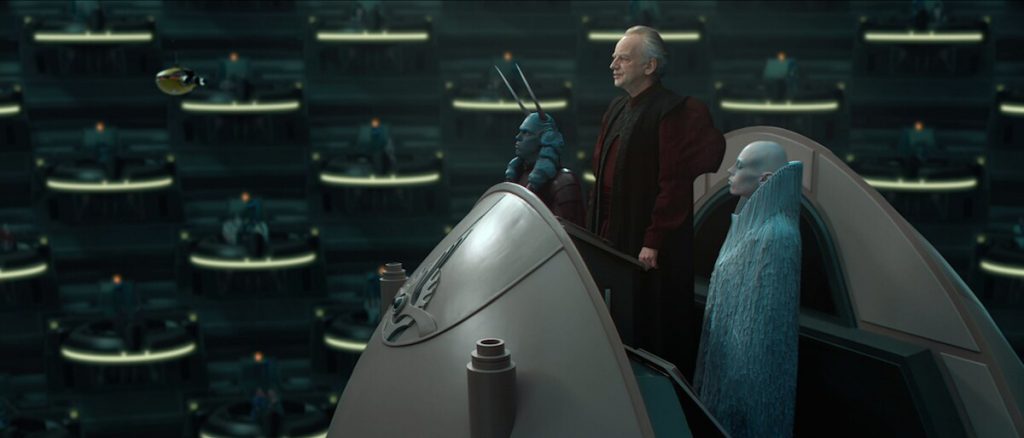With Star Wars: Episode III – Revenge of the Sith, George Lucas concludes his flawed prequel trilogy on an emotional, erroneous note.
Director: George Lucas
Genre: Sci-Fi, Action, Adventure
Run Time: 140′
Release Date: May 16, 2005
Watch Star Wars: Episode III – Revenge of the Sith: on digital
I’m a prequel kid. I was a young child when George Lucas delved back into his Star Wars treasure trove, one of the most impressive and unique pieces of cinematic worldbuilding audiences have ever seen. Watching Episodes I, II, and III, then, contain a certain level of nostalgia that I am unable to shake (despite my best intentions).
This feeling holds especially true for Revenge of the Sith. All one would need to do is ask my younger sister about my incessant listening of the film’s score – which I owned on CD – on our drives to school which (assuredly drove both her and my grandfather quite crazy).
As I grew up and began studying film, I would easily spot the imperfections in the prequel trilogy. The poor CGI and cringeworthy dialogue began to stick out more and more. I could objectively see the prequels were less than masterpieces. And yet, subjectively, I still found them entertaining, goofy, and above all, deeply idiosyncratic. Watching Revenge of the Sith for what had to have been the 100th time, I discovered a newfound appreciation for Lucas’ vision. The film is flawed and somewhat misguided but is all those things in a way that is deeply distinct and personal. It is unapologetically Lucas’ film, and that alone gives Revenge of the Sith merit.
Revenge takes place at the tail end of the Clone Wars, a conflict between the Galactic Republic (aided by the Jedi Council) and the Separatists, aided by a secret sith Lord. The story follows Jedi Knight Anakin Skywalker (Hayden Christensen) as he grows increasingly disillusioned with the Jedi and seeks to save his secret wife, Senator Padme Amidala (Natalie Portman, of May December), after seeing visions of her death.

To label Revenge of the Sith “the best prequel” is not an unpopular opinion, but what makes it so? For one, Lucas’ worldbuilding – something that has always been his strength – takes a leap forward here. One main critique of Episode I – The Phantom Menace and Episode II – Attack of the Clones was the obvious use of green screens, leaving many shots feeling cold and inauthentic. Revenge, while not fixing all of the visual issues, does feel more real, and certain sequences are quite successful in taking viewers into the galaxy far, far away.
The opening scene, where Skywalker and Obi-Wan Kenobi (Ewan McGregor, of Bleeding Love) attempt to rescue Chancellor Palpatine (Ian McDiarmid) from General Grievous during a battle is one example. The sequence contains an opening tracking shot of their ships flying through others over the planet Coruscant. This scene alone looks better than anything in the first two episodes of the prequel trilogy. It also feels like classic Star Wars: it’s fun, quippy, and expertly executed action. It’s those qualities that make Lucas’ worldbuilding feel unmatched.
Secondly, Lucas goes for a darker tone in Revenge of the Sith, balancing the story of Anakin Skywalker’s transformation into Darth Vader with some prescient political ideas the filmmaker has always found interesting. With this darker tone comes some of the very best moments in the trilogy. Order 66, a fan-favorite moment showing Palpatine ordering clone troopers, fighting with the Jedi and the Galactic Republic, to turn on the Jedi, and Anakin’s climactic showdown with his former master, Obi-Wan, can still effectively send a chill down the spine of any Star Wars fan. These scenes work because they play into Lucas’ strengths: visual storytelling, action, and a sense of intimacy for these characters.
Unfortunately, many of the issues that plague Episodes I and II are also present in Revenge of the Sith. One noticeable similarity between all the film’s best scenes is that they contain little-to-no dialogue. Script writing has never been Lucas’ strengths, and the prequels unfortunately highlight this. While Revenge contains nothing quite as egregious as “I don’t like sand,” it still contains wooden lines accompanied by wooden deliveries (usually from Christensen or Portman).
The dialogue issues feel even greater here because of the weight, tragedy, and extra sense of grandeur Lucas is trying to aim for with this film. Acting as a bridge between the prequel and original trilogies, as well as completing a tragic arc for Skywalker, Revenge of the Sith had much to accomplish. As a pure visual spectacle, it accomplishes its mission, but Lucas often gets in his own way with a line or moment that could potentially derail the movie’s best moments.
One need not look any further than the scene where Anakin finally dons the Darth Vader garb for the first time. The iconic helmet lowers onto a severely injured Anakin. He breathes through the helmet for the first time, a puff of smoke rising further into the air as he exhales. Awesome right? Only moments later, Vader screeches “NOOOOO!” when Palpatine tells him that Padme is dead. The scene is one of the goofiest, most memeable moments in the Star Wars canon. Moments like this often directly precede or follow some of the movie’s highest highs.
Despite the movie’s flaws (or perhaps even because of them), Revenge of the Sith, and the prequels in general, should be celebrated as an idiosyncratic achievement that audiences very rarely see in our galaxy’s movie industry. The best and the worst of the film came from the mind of one man: Lucas. In an age of studio interference and inter-connected universes, the prequels, and Revenge in particular, stand out as a purely unique creation, and that alone is worth celebrating. Love it or hate it, Revenge of the Sith is Lucas’ unaltered creation, one that ends with a new hope for the characters in that galaxy. The film may also, in retrospect, be viewed as a hopeful reminder of what big budget auteurism can look like, and what a pure creative vision is able to achieve.
Star Wars: Episode III – Revenge of the Sith is now available to watch on digital and on demand. Find out if the Star Wars prequels are actually bad and why The Last Jedi is a Great Sequel to The Force Awakens, and read our ranking of the best music of Star Wars from worst to best!
Loud and Clear Reviews has an affiliate partnership with Apple, so we receive a share of the revenue from your purchase or streaming of the films when you click on the button on this page. This won’t affect how much you pay for them and helps us keep the site free for everyone.

